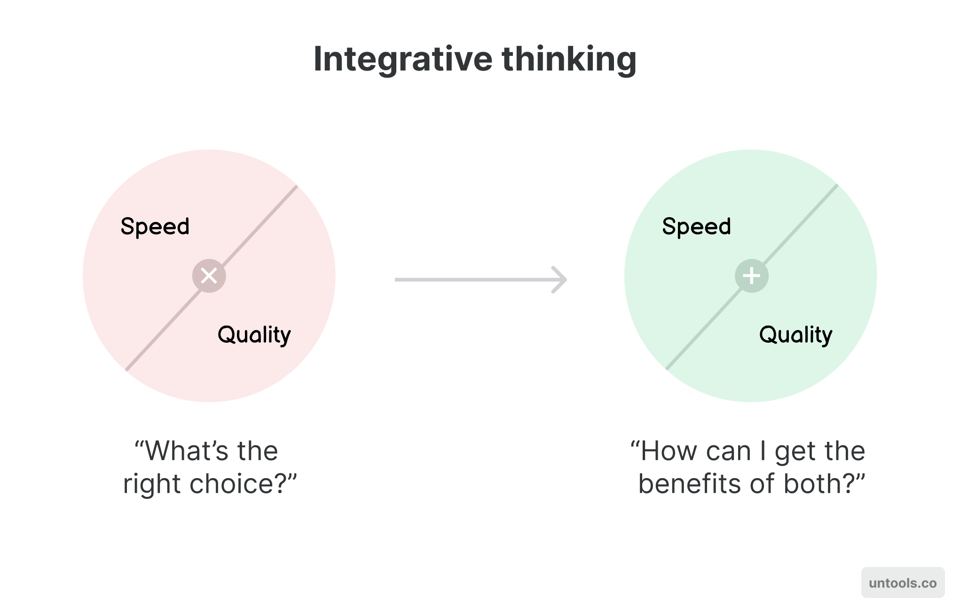Integrative thinking: moving beyond either/or choices
Hi there, it’s Adam from Untools.
When it comes to approaching complex problems, many people follow the brain’s natural tendency to simplify and reduce the problem to a couple of choices which are often opposing. It’s then nearly impossible to pick the “right” choice.
Or we can choose a more holistic approach and embrace the complexity with integrative thinking.
Problem with either/or thinking
When dealing with opposing ideas, our brains tend to look for the “best” option. Examples of opposing ideas include speed or quality, creativity or structure, centralisation or autonomy. In most contexts, there isn’t a clear winner. So what if you didn’t have to choose just one?
That’s where integrative thinking comes in. It was formulated by Roger Martin, former dean of Rotman Schools of Management in Toronto. The key idea is to combine the best of different perspectives.
Martin describes it as the ability to constructively face the tension of opposing ideas and generate a creative resolution that has elements on both ideas but is superior to them.
It’s about asking “How can I get the benefits of both ideas?”

How to develop integrative thinking
Integrative thinking is not a natural skill but a one we have to build. It starts with pushing against our tendency to simplify and choose.
Here are some thinking points to help you start developing this skill:
Look beyond your options: When dealing with what seems like either/or choices, ask yourself: “Are these really the only options? What if I didn’t have to choose?”
Consider both opposing ideas: Instead of dismissing any one option, consider the benefits of each. How might you reap them?
Remember the higher goal: Even if the choices in front of you seem opposing, both should be ways to a higher goal. Try evaluating ideas based on how they serve that goal instead of seeing them as mutually exclusive.
Apply this with Polarity mapping
Next week, 💎 Vault members will receive a detailed guide on how to use polarity mapping - a practical framework for dealing with ongoing tensions rather than problems to solve. It will cover:
How to identify when you're facing a polarity versus a problem
A step-by-step process for mapping polarities
How to develop action plans to get benefits of both sides
A downloadable template to apply this framework immediately
Members receive a monthly post with deep dives, guides and exclusive templates. And they get instant access to all the previous premium content.
Real-world applications for integrative thinking
Integrative thinking doesn’t have to be just for big complex work problems. You can also apply it to more every day challenges:
In parenting: How to balance freedom and boundaries for children
In career development: How to specialise while maintaining a general skillset
In communication: How to be honest yet kind when giving feedback
In these cases, the most effective approach isn’t choosing one over the other but finding ways to get benefits of both.
The "Yes, and..." technique
While integrative thinking helps with conceptual problem-solving, here's a simple communication technique you can start using today: the "Yes, and..." approach.
Originally an improv theatre technique, it changes how we respond to ideas that differ from our own. So instead of defaulting to "Yes, but..." (which implies negating everything before the "but"), you can try saying "Yes, and..."
Let's look at an example:
Colleague: "We should be focusing on acquiring new customers."
Traditional response: "Yes, but we need to keep our existing customers happy as well." (Goes into opposition)
"Yes, and..." response: "Yes, and if we improve our onboarding process, new customers will be more likely to stay longer."
The benefits of this technique lie in:
Validating the other person's perspective
Building on ideas instead of dismissing them
Supporting collaboration
Coming next
Next month, we'll look at systems thinking and specifically Connection circles - a powerful visual tool that helps you understand relationships in a system.
Until then,
Adam
P.S. As always, I’d love to hear your feedback on this newsletter or any questions you might have. Feel free to reply directly to this email.
Add a comment: